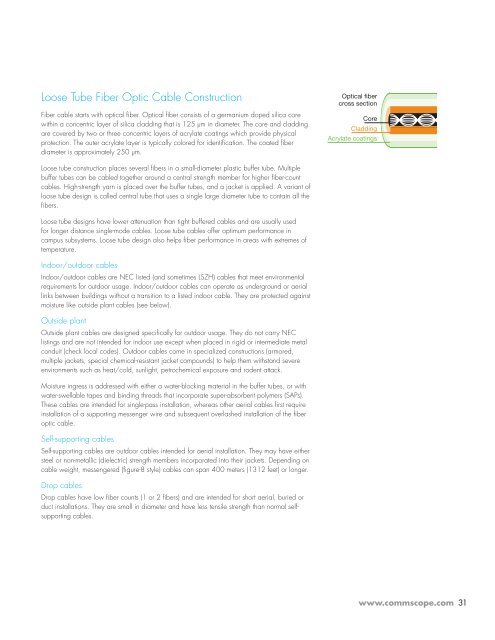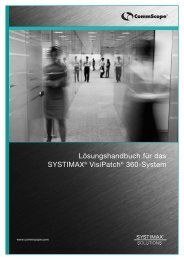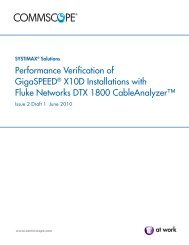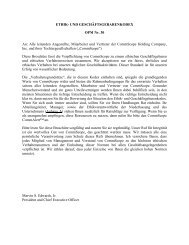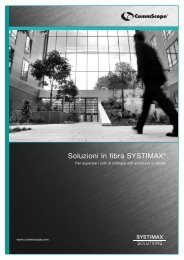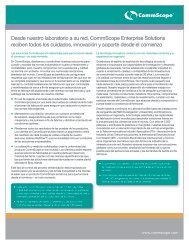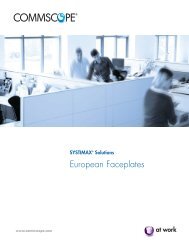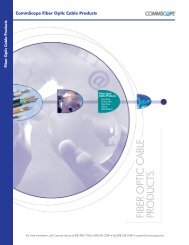Enterprise Design Guide - Public - CommScope
Enterprise Design Guide - Public - CommScope
Enterprise Design Guide - Public - CommScope
Create successful ePaper yourself
Turn your PDF publications into a flip-book with our unique Google optimized e-Paper software.
Loose Tube Fiber Optic Cable Construction<br />
Fiber cable starts with optical fiber. Optical fiber consists of a germanium doped silica core<br />
within a concentric layer of silica cladding that is 125 µm in diameter. The core and cladding<br />
are covered by two or three concentric layers of acrylate coatings which provide physical<br />
protection. The outer acrylate layer is typically colored for identification. The coated fiber<br />
diameter is approximately 250 µm.<br />
Loose tube construction places several fibers in a small-diameter plastic buffer tube. Multiple<br />
buffer tubes can be cabled together around a central strength member for higher fiber-count<br />
cables. High-strength yarn is placed over the buffer tubes, and a jacket is applied. A variant of<br />
loose tube design is called central tube that uses a single large diameter tube to contain all the<br />
fibers.<br />
Loose tube designs have lower attenuation than tight buffered cables and are usually used<br />
for longer distance single-mode cables. Loose tube cables offer optimum performance in<br />
campus subsystems. Loose tube design also helps fiber performance in areas with extremes of<br />
temperature.<br />
Indoor/outdoor cables<br />
Indoor/outdoor cables are NEC listed (and sometimes LSZH) cables that meet environmental<br />
requirements for outdoor usage. Indoor/outdoor cables can operate as underground or aerial<br />
links between buildings without a transition to a listed indoor cable. They are protected against<br />
moisture like outside plant cables (see below).<br />
Outside plant<br />
Outside plant cables are designed specifically for outdoor usage. They do not carry NEC<br />
listings and are not intended for indoor use except when placed in rigid or intermediate metal<br />
conduit (check local codes). Outdoor cables come in specialized constructions (armored,<br />
multiple jackets, special chemical-resistant jacket compounds) to help them withstand severe<br />
environments such as heat/cold, sunlight, petrochemical exposure and rodent attack.<br />
Moisture ingress is addressed with either a water-blocking material in the buffer tubes, or with<br />
water-swellable tapes and binding threads that incorporate super-absorbent polymers (SAPs).<br />
These cables are intended for single-pass installation, whereas other aerial cables first require<br />
installation of a supporting messenger wire and subsequent overlashed installation of the fiber<br />
optic cable.<br />
Self-supporting cables<br />
Self-supporting cables are outdoor cables intended for aerial installation. They may have either<br />
steel or non-metallic (dielectric) strength members incorporated into their jackets. Depending on<br />
cable weight, messengered (figure-8 style) cables can span 400 meters (1312 feet) or longer.<br />
Drop cables<br />
Drop cables have low fiber counts (1 or 2 fibers) and are intended for short aerial, buried or<br />
duct installations. They are small in diameter and have less tensile strength than normal selfsupporting<br />
cables.<br />
Optical fiber<br />
cross section<br />
Core<br />
Cladding<br />
Acrylate coatings<br />
www.commscope.com 31


